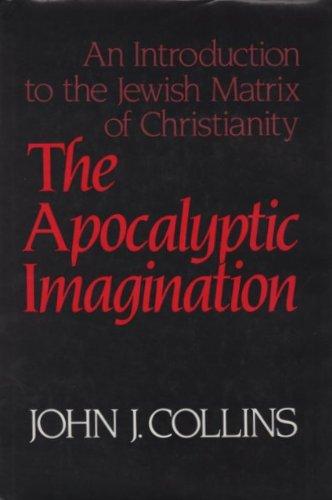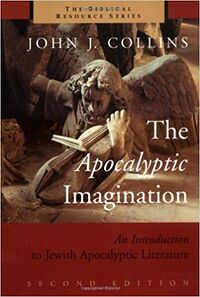File:1984 * Collins.jpg
1984_*_Collins.jpg (332 × 500 pixels, file size: 19 KB, MIME type: image/jpeg)
The Apocalyptic Imagination: An Introduction to the Jewish Matrix of Christianity is a book by John J. Collins.
Abstract
"An introduction to the major texts typically designated apocalypses proper as well as apocalyptic leaning texts such as oracles and testaments, this look at the apocalyptic genre seeks to understand each individual text on its own terms. Challenging several dominant trends in contemporary scholarship of the Jewish apocalypses, Collins maintains the importance of apocalyptic as genre, as a way of fostering discussion and understanding, over viewing the texts as part of a coherent “Apocalyptic Movement.” Against those scholars on a quest for the “origins of apocalyptic” Collins rejects any type of unilinear genetic relationship. Instead of viewing this group of texts as a child of prophecy or as a foreign adaptation of Persian dualism, Collins sees the matrix of Jewish apocalyptic in the general Hellenistic milieu, where Babylonian, Persian, Greek, and Egyptian ideas circulated freely, and in the “Hellenistic Mood,” a general nostalgia for the past and a feeling of alienation from the present. These texts are sufficiently diverse that one cannot speak of a single apocalyptic social group. Each apocalypse may represent its own individual or group and the social settings must be sought for each individual text. It is in this sense, each text being dealt with on its own terms, where the importance of Collins' book lies. No longer could one speak of apocalypticism as a sort of monolith. Influences, social settings, historical circumstances all must be sought on a text by text basis. The second edition included thorough revisions and expansions (most notably in the sections on Qumran and Christianity) and updated footnotes and bibliography."-–Jason Zurawski, University of Michigan
Editions
Published in New York: Crossroad, 1984. 2nd ed.: The Apocalyptic Imagination: An Introduction to Jewish Apocalyptic Literature (Grand Rapids, MI: Eerdmans, 1998)
- The Apocalyptic Imagination, 2nd ed. (1998 @1984 Collins), book
- The Apocalyptic Imagination, 3rd ed. (2016 @1984 Collins), book
Table of contents
- 1. The Apocalyptic Genre
- 2. The Early Enoch Literature
- 3. Daniel
- 4. Related Genres: Oracles and Testaments
- 5. Qumran
- 6. The Similitudes of Enoch
- 7. After the Fall: 4 Ezra, 2 Baruch, and the Apocalypse of Abraham
- 8. Apocalyptic Literature from the Diaspora in the Roman Period
- 9. Apocalypticism in Early Christianity
- Epilogue
2nd edition (1998)
- John J. Collins, The Apocalyptic Imagination: An Introduction to Jewish Apocalyptic Literature' (Grand Rapids, MI: Eerdmans, 1998)
"This second edition of John J. Collins's widely praised study of Jewish apocalyptic literature represents a complete updating and rewriting of the original work. Especially noteworthy is the chapter on the Dead Sea Scrolls, which now takes into account all of the recently published texts. Other chapters discuss apocalypse as a literary genre, explore the phenomenon and function of apocalypticism in the ancient world, study a wide range of individual apocalyptic texts, and examine the apocalyptic character of early Christianity."--Publisher description.
"Apocalyptic literature evokes an imaginative world that is set in deliberate counterpoint to the experiential world of the present. Apocalypticism thrives especially in times of crisis, and it functions by offering a resolution of the relevant crisis, not in practical terms but in terms of imagination and faith. The Apocalyptic Imagination by John Collins is one of the most widely praised studies of Jewish apocalyptic literature ever written. And this second edition of Collins's study represents a complete updating and rewriting of the original work. Especially noteworthy is the chapter on the Dead Sea Scrolls, which now takes into account all of the recently published texts. Other chapters discuss apocalypse as a literary genre, explore the phenomenon and function of apocalypticism in the ancient world, study a wide range of individual apocalyptic texts, and examine the apocalyptic character of early Christianity."--Publisher description.
Translation: Korean (2006) ==
3rd edition
John J. Collins, The Apocalyptic Imagination: An Introduction to Jewish Apocalyptic Literature (Grand Rapids, MI: Eerdmans, 1998).
"One of the most widely praised studies of Jewish apocalyptic literature ever written, The Apocalyptic Imagination by John J. Collins has served for over thirty years as a helpful, relevant, comprehensive survey of the apocalyptic literary genre ... After an initial overview of things apocalyptic, Collins proceeds to deal with individual apocalyptic texts — the early Enoch literature, the book of Daniel, the Dead Sea Scrolls, and others — concluding with an examination of apocalypticism in early Christianity. Collins has updated this third edition throughout to account for the recent profusion of studies germane to ancient Jewish apocalypticism, and he has also substantially revised and updated the bibliography."--Publisher description.
Contents: 1. The Apocalyptic Genre -- 2. The Early Enoch Literature -- 3. Daniel -- 4. Related Genres: Oracles and Testaments -- 5. The Dead Sea Scrolls -- 6. The Similitudes of Enoch -- 7. After the Fall: 4 Ezra, 2 Baruch, and the Apocalypse of Abraham -- 8. Apocalyptic Literature from the Diaspora in the Roman Period -- 9. Apocalypticism in Early Christianity -- Epilogue
External Links
File history
Click on a date/time to view the file as it appeared at that time.
| Date/Time | Thumbnail | Dimensions | User | Comment | |
|---|---|---|---|---|---|
| current | 12:37, 22 July 2018 |  | 332 × 500 (19 KB) | Gabriele Boccaccini (talk | contribs) |
You cannot overwrite this file.
File usage
The following 2 pages use this file:


